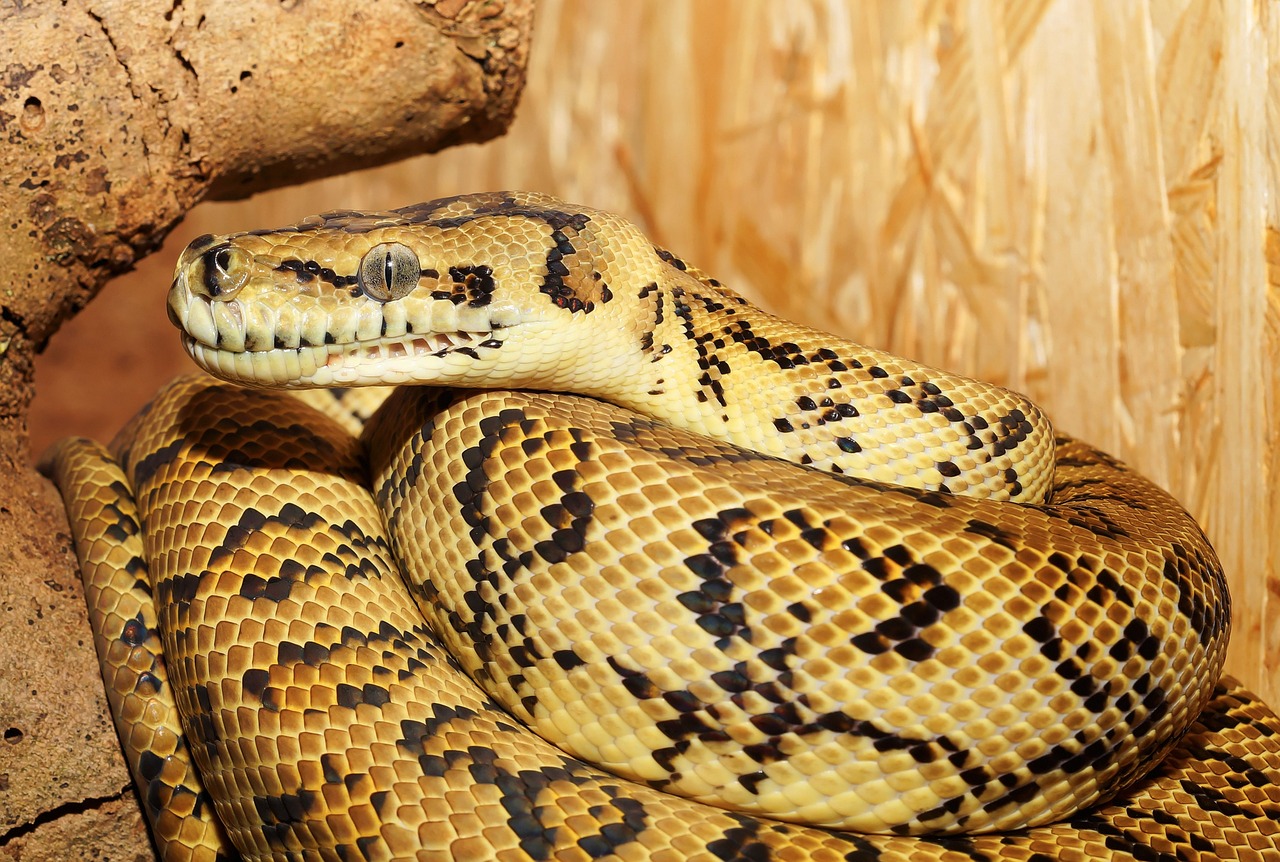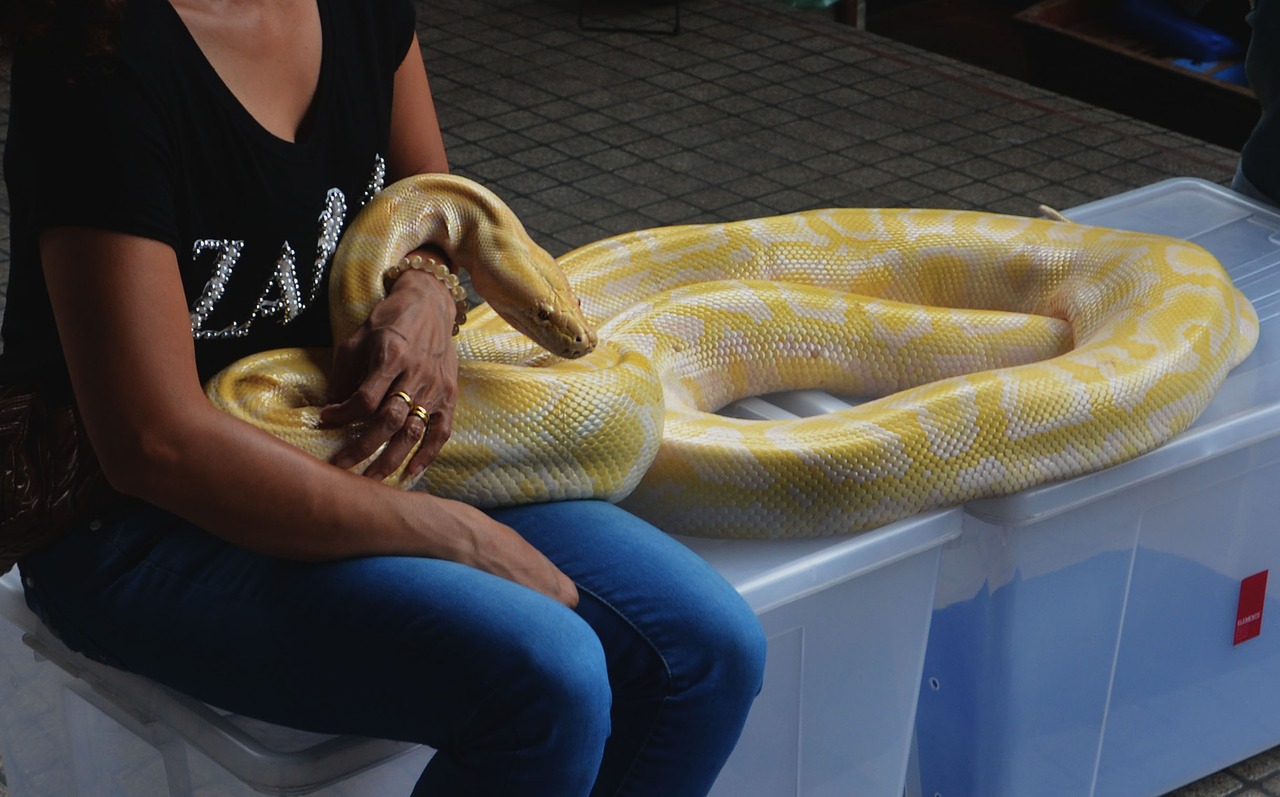PYTHON SNAKES --- THE MASSIVE/MOST FEARED BUT YET NON VENOMOUS IN THE SNAKE FAMILY
Pythonidae commonly known as python is one of the biggest and largest kind of snake in the world, mostly found in Africa, Asia and Australia.

THEY ARE NON-VENOMOUS NEITHER ARE THEY POISONOUS
I think people misunderstand the difference between venomous and poisonous animals or insects, which I'm going to explain here.
VENOMOUS : An animal or insects is considered to be venomous when it harms you by biting or by stinging like rattle snake, scorpion, black widow spider, jelly fish, etc..
Pythons are non venomous even though they have long curve teeths, that are scary they don't have the ability to generate venom in them and that's their nature. But their bite should be treated immediately to avoid infections.
POISONOUS: something is considered poisonous when you are harmed during ingestion either by eating or drinking it like the poisonous mushroom, and some household insecticide.
Python snake are eaten by humans so it is not poisonous.
They are dangerous and most members of this family are ambush predators, in that they typically remain motionless in a camouflaged position, and then strike suddenly at passing prey. Generally they will not attack humans unless startled or provoked, although females protecting their eggs can be aggressive. They kill their prey through constriction, literally by squeezing the animal to death while Venomous snakes, on the other hand, kill their prey by biting and injecting venom through hollow fangs or teeth.


Not all python can be used as pet but If you would like to keep a member of the Pythonidae family as a pet, then you should consider the following species:
- The Ball python : These snakes are docile and are generally easy to handle. They don't get large enough to pose a threat of constriction and they rarely grow larger than 5 - 6 ft (152 - 182 cm) and the average adult size is even smaller than that.
The Blood python : These particular ones are not for beginners, but they are generally safe to keep as pets but they can deliver a nasty bite, like any other python, but they do not grow large enough to be dangerous to humans. They grow slightly larger than ball pythons and are thick, heavily built snakes. But they are not large enough to constrict an adult human.
The Children's python :These specie of the python family did not get their name because they are recommended for children, actually they were named after English zoologist John George Children. Adults grow to an average length of around 3 ft (1 m) and rarely exceed 5 ft (1.5 m) and due to their relatively small size (and the fact that they are non-venomous like all pythons), these snakes are not considered dangerous to humans.

They love staying in where it is hot and wet and their huge bodies can stay warm and they love making their homes in caves or in trees and have become used to living in cities and towns since people have been moving in on their territory.
Their closeness to people means that not only will the snakes hunt the livestock which are the pigs, goats, dogs, cats and chickens, actually it also means that they may attack people when feeling threatened, although this rarely happens. Speaking of them being threatened, one of the biggest reasons that pythons are killed is for their large, beautiful skins. and Some people actually like to wear snakeskin pants, vests, cowboy boots, and shoes.
Larger Pythons are constrictors, which means that they will ‘squeeze’ the life out of their prey. They actually coil themselves around their prey and with each breathe the creature takes the snake will squeeze a little tighter until they stop breathing completely and immediately the heart stops the prey is swallowed whole. The entire animal is digested in the snake’s stomach except for fur or feathers. What happens to the fur, feathers, beaks, and eggshells which are the ‘extra stuff’ is that they are passed out as waste through their anus.
Also pythons feed on wild animals such as lizards, caiman (small alligator-like animals), monkeys and antelope the truth is that the larger the meal, the longer it takes to digest. This means that a python may only need to eat 4-5 times a year, isn't it amazing???
Most of the python species have heat-sensing labial pits to aid them in finding warm-blooded prey, but Pythons that feed on cold-blooded prey do not have the labial pits. Irrespective of the length, pythons are bulky for their size and they have a triangular-shaped heads and a sharp backward-curving teeth which they use to grab prey. The Arboreal pythons teeth are usually longer than their terrestrial and they also have extremely prehensile tails.
Why Pythonidae is considered as a primitive family of snakes is because pythons have remnants of a pelvis and small vestigial hind limbs, called the spurs, located on either side of their cloaca. The spurs of males are larger than the spurs of the females, they also have two lungs, a primitive characteristic, since most snakes have evolved to have only one lung.
Also due to how bulky they are, they move by scooting forward in a straight line which is known as “the rectilinear progression” movement, Pythons usually stiffen their ribs for support against the ground then lift their bellies and push themselves forward, It is a slow form of movement and pythons can’t go more than 1 mph (1.6 kph).
The amazing part is that many species of python are excellent swimmers, while others are arboreal and they usually hang from branches with their prehensile tail.

The Pythons are ambush predators, capable of swimming and may lie partially submerged in shallow water waiting for prey to visit the water body. Arboreal pythons, such as the green tree python, launch themselves from branches onto prey below that could cause a serious injury to the snake,but rather, they lie still on a branch and wriggle their tails to lure in their prey and strike while still in the tree, according to the World Association of Zoos and Aquariums.
They grab their prey in their long teeth and kill it by constriction. Contrary to popular belief, constriction does not mean crushing. Pythons and other constricting snakes do not use their strength to break their prey’s bones. Many scientists think that pythons suffocate their prey, squeezing the prey’s ribs so that it cannot breathe. But in 2015, however, a paper revealed the long-held suffocation theory to be incorrect in boa constrictors, probably the most famous constrictor.
The paper actually revealed that squeezing overwhelms the circulatory system, cutting blood off from the brain and causing death. After they have successfully killing the prey, they will slowly open their jaws and swallow the prey whole, head first. Once the meal is consumed, pythons rest in a warm place while they digest.

The Pythons are oviparous, which actually means they lay eggs. This makes them differ from the family Boidae (boas), most of which bear live young (ovoviviparous). After the laying of eggs which is done by the females , they typically incubate them until they hatch. This is process is achieved by causing the muscles to "shiver", which increases the temperature of the body to a certain degree, thus keeping the eggs at a constant temperature is essential for healthy embryo development, During the incubation period, the females will not eat and only leave to bask to raise their body temperature.
The female python usually delay reproduction until they have enough energy to breed a large clutch of eggs. Therefore, they they produce in vast amount when there is plenty of food, that is, the proportion of pythons reproducing each year is tightly connected to prey availability
REFERENCES
click on the references for further information



)
)